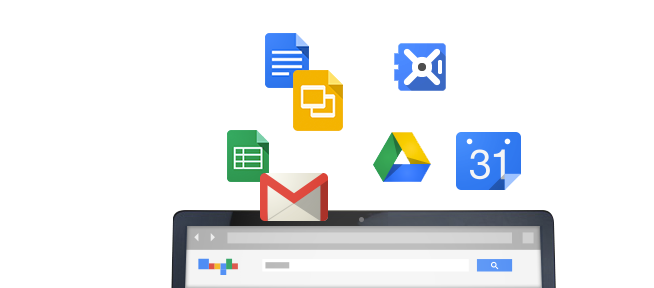47 Stats You Need to Know About the G Suite Ecosystem
October 23, 2013
8 minute read

Since Google launched G Suite in 2006, there’s been considerable growth and adoption of the suite. The last reported numbers state that there are over 5 million organizations on G Suite with 50 million users and it seems like more organizations go Google everyday – in fact the US Army went Google this week!
We’ve rounded up 47 of the most important stats alluding to the platform’s adoption, growth and future.
Moving to the Cloud
We’ve known for a while that a large shift is underway in the realm of IT. The move to the cloud, first propelled by early adopters and championed by Google, Salesforce.com and others is becoming more and more mainstream.
- According to Mark Murphy, an enterprise software analyst at Piper Jaffray, today 9.7% of all computing workloads are run in the public cloud. However, that number is expected to rise to 30.2% in just five years, adding up to 44% annual growth in workloads for the public cloud compared to just 8.9% growth for on-premise computing workloads. Source.
- In organizations operating on G Suite with 1,000+ users, IT admins believe it will take on average 5 years for a full move to the cloud. Source.
- 29% of G Suite admins have already transitioned their IT infrastructure 100% to the cloud and 73% of admins feel a full move to the cloud is inevitable. Source.
- In 2013, Cloud Business Email mailboxes represent 27% of Business mailboxes worldwide. Source.
- 545 cloud services are in use by an organization on average, and the highest number of cloud services in use by an organization is 1,769. Source.
- [In 2012] the majority of businesses are adopting cloud computing – 38% have already adopted cloud computing and a further 29% are making plans to adopt it. 89% of financial decision-makers are aware of their organizations’ plans to adopt cloud computing and 66% have been involved in the decision as to whether cloud computing should be adopted in their organization. Source.
Examining the Adoption of G SUite
Small and large businesses differ widely in how they adopt G Suite. Generally, smaller business are quicker to adopt G Suite. This could be for myriad reasons including cost savings, mobile or remote workforces, small prior investments in on-premise systems and ease of migration.
One obstacle we often hear from larger organizations stems from the lack of granular controls and “back office” features associated with G Suite. However, an ecosystem of third-party providers has emerged to fill these gaps and we’ve seen adoption of the suite from some of the world’s largest businesses – including Whirlpool.
- Gartner found that Google’s cloud-based productivity suite (ie. Docs, Sheets, Slides, etc.) is taking market share from Microsoft. G Suite had about 10 percent of the cloud-office market in 2007, 20 percent in 2009, and between 33 percent and 50 percent in 2012. Source.
- In 2011, Gartner analysts believed that Gmail had no more than 1% of the enterprise email market, but it had close to 50% of the market for enterprise cloud email, where it competes with MSFT, IBM and smaller vendors. Source.
- In 2013, Gartner expects there will be 630 million productivity suite business users, with 50 million of them using a cloud-based product. By 2022, there will be 1.2 billion office suite business users, with 695 million of them using the cloud. Source.
- For smaller businesses, 63% support or plan to support Gmail. At larger companies, in contrast, only 29% support or plan to support Gmail. Just 20% of companies with 50 or more employees have deployed G Suiteand Gmail; an additional 6% encourage use, while 28% discourage or ban use outright. Source.
- In small companies, 39% have apps and Gmail deployed, and an additional 11% encourage use versus 11% who discourage or ban G Suite. Source.
- When asked what percentage of their business apps will come from Google in two years, two-thirds of small-business users say that 25% or less of their apps will come from Google compared with a whopping 87% of large businesses saying the same. A big part of this disparity is because Google doesn’t offer back-office and other applications crucial to larger businesses. Source.
- On the 2013 Q2 Google earnings call, Nikesh Arora, Senior Vice President and Chief Business Office at Google, said more than half of Fortune 500 companies are paying for Google enterprise products, and some 5 million companies are using G Suite for Business. Source.
The Continued Growth of Google Enterprise
While Google Enterprise may be a little known entity to the world at large, this sector is growing within Google and even propelling its earnings. This signals to Microsoft and other G Suite competitors that competition for customers is only going to grow more contentious.
- Google Enterprise products are comprised of G Suite, Google Search Appliance, Google Cloud Services, Geospatial and Mapping Products and Chromebooks for Businesses. Source.
- G Suite represented just 1.4 percent of the company’s fourth-quarter 2012 revenue. Source.
- In 2012, Google booked more than 96% of its revenue from ads. The remaining 4% came from its enterprise products. While small in terms of percentage of revenue, Google’s Enterprise products accounted for $1.37 and the sector is growing by about 30% a year. Source.
- Gartner analyst Tom Austin claimed that Google has overall better cloud infrastructure than Microsoft at this point (April 2013) and doesn’t see Google pulling out of the productivity suite business as its 1.4 percent G Suite revenue could grow to 5 percent in 2017. Source.
- Arora goes onto describe four major trends are driving growth: 1) rise of multi-screen consumer; 2) ability to deliver more precise answers to consumers; 3) Google offers lots of places to advertise, including brand options on YouTube and elsewhere; 4) Google’s apps/enterprise business. Source.
- About 1,200 or about 3.6% of all Google employees work on Enterprise initiatives. Source.
Cloud Services Brokerages
The growth of adoption of G Suite has also fostered the growth of cloud services brokerages (CSBs) dedicated to helping their customers make the most out of the G Suite platform. In addition to providing migration expertise, CSBs have been employed by larger organizations to assist with custom development and integrations.
- Over 30% of enterprises using G Suite are working with a reseller to integrate Apps with other cloud applications to create a fully communicative cloud suite. Source.
- And G Suite administrators want their resellers to make more recommendations when it comes to building out their company’s cloud suite. 20% of G Suite admins would like their reseller to provide recommendations for third-party software that integrates with G Suite. Source.
- In 2011, Google stated that the G Suite partner community more than doubled since 2010 to over 2,500 certified partners operating in 70 countries. Source.
- As of July 2012 Google stated there were 6,000 G Suite resellers serving businesses, government agencies and educational institutions around the world. Source.
Reasons for Migrating to G Suite
While cost savings may be a leading factor driving adoption of G Suite from very small organizations, we’ve found that providing users access to their data from virtually anywhere is seen as the most appealing benefit. As BYOD and the consumerization of IT continue to disrupt the workplace, this benefit will only grow in significance.
- 51% of G Suite admins cite user access to data from anywhere as the key benefit of moving to the cloud. Source.
- Less than one third of G Suite admins in organizations with 1,000 or more users cited cost savings as a key benefit of moving to the cloud. Source.
Microsoft Office
From BetterCloud’s own studies, we know that users are often reluctant to leave behind legacy software – in most cases that means Microsoft Office – Word, Excel and PowerPoint. However, it’s encouraging to note that as companies spend more time on the G Suite platform, they’re able to decrease their investment in Microsoft Office.
- Google is doing to Microsoft as Microsoft has done to countless competitors: releasing products that are pretty good, improving incrementally and making them so affordable that, at some point, it’s hard to justify not making the switch. That’s especially true when most of your company’s employees have Gmail and G Suite accounts and aren’t shy about using them for business. Source.
- Over 60% of G Suite customers are minimizing further investment in Microsoft Office. Source.
- 64% of G Suite admins who have been on G Suite for two or more years said that they are minimizing further investment in Microsoft Office. Source.
- In organizations using G Suitewith 500 more users, 62% are minimizing further investment in Microsoft Office. Source.
G Suite vs. Office 365
Microsoft has been feeling the heat from Google since its platform’s launch in 2006. To compete with its own cloud-based messaging and collaboration platform, Redmond launched Office 365 in 2011. So far adoption of the suite has been slow.
- Gartner: We are at the start (2011) of a major escalation in the war of the email clouds. As part of the June 2011 launch of Office 365, Microsoft released a cloud email service based on Exchange 2010. Exchange was designed to be an on-site enterprise email system, and Microsoft’s main challenge is to deliver a cloud version of Exchange that faithfully reproduces the capabilities of an on-premises deployment. Google, on the other hand, built Gmail exclusively for the cloud and for consumers; its challenge is to deliver broad enterprise capabilities for Gmail. Source.
- Gartner analysts also predicted that in 2011 cloud email was still in its infancy – at 3% to 4% of the overall enterprise email market, but expected it to be a growth industry, reaching 20% of the market by year-end 2016, and 55% by year-end 2020. Based on this growing demand for cloud email services, Google’s prospects for continued success in the email market are strong. At this point, Google should be considered the only significant threat to Microsoft in the enterprise email market. Source.
- Two years later Gartner’s Tom Austin says that G Suite is better suited for heterogeneous environments, while Microsoft Office is “wed to Windows.” “Whatever Microsoft does on iOS or Android [with Office] is not going to be world class.” Source.
- Austin noted that Microsoft has been losing market share in the broader operating system platform wars, and added that “we think most organizations will be heterogeneous, so Microsoft’s strategy [of Office being tied to Windows] won’t be effective in the long run.” Source.
- Austin adds that going with G Suite represents the best heterogeneous strategy, with more innovative products and better cloud-based infrastructure. As for Microsoft Office 365, Austin said that “it’s evolutionary” and that “we’re not sure Microsoft can beat Google’s pace of innovation.” Source.
Role of the G Suite Ecosystem
An obstacle many organizations worry about overcoming on their way to the cloud is the lack of granular controls and comparable software in the cloud. The G Suite Marketplace, Chrome Web Store and Drive installable applications have emerged to help organizations fully realize the potential of G Suite and make their use of the platform easier and more secure.
- 28% of G Suite admins in organizations with 1,000 or more users say a lack of key comparable functionality is keeping them from fully moving their organizations to the cloud. Source.
- Google launched the G Suite Marketplace in March 2010 with over 50 companies selling applications in the Marketplace. Source.
- By 2011, the Marketplace had more than 300 applications listed. Google also made three key observations on the one year anniversary on the Marketplace: 1) Web app adoption is accelerating across every business function and need. 2) Customers value web apps that work together — what Google calls integrated apps. 3) It’s harder than ever to evaluate and select the right app, given the number of new apps coming to market, and their increasing specialization. *Note: BetterCloud believes the number of applications listed in the Marketplace is now over 600. Source.
- A typical G Suite admin installs 6 G Suite Marketplace applications, but keeps only 3. Source.
- Peer review is the number one factor driving Marketplace installs. Source.
G Suite for Education
The education sector has perhaps adopted G Suite more quickly than any other. For educational institutions, Google provides G Suite free of charge, so it’s almost a no brainer when looking at price (or lack thereof) and existing familiarity of many students with Google products (Gmail, Chat, Calendar etc.). For similar reasons including cost savings and ease of use, educational institutions have also been quick to embrace Chromebooks – Google’s affordable, web-only netbook-like device.
- Over 20 million students use G Suite for Education around the world. Source.
- 72 of the top 100 US universities use G Suite including Princeton, Brown, Northwestern, Georgetown and Vanderbilt. Source.
- In 2013, Malaysia’s Ministry of Education adopted G Suite for Education for 10 million students. Source.
- According to the National Survey on Mobile Technology for K-12 Education, 81 percent of respondents had adopted or planned to adopt an iPad, up from 73.5 percent in 2012, while 31 percent had adopted or planned to adopt a Chromebook, up from 14 percent in 2012. Source.
Chromebooks in the Enterprise
While schools have been arguably the quickest segment to embrace Chromebooks, we’re seeing an upward trend in adoption of the device in businesses. At BetterCloud, we’ve fully embraced Chromebooks – especially the Pixel (both our CEO and Director of Marketing use these devices full time). While we’re no doubt early adopters, the trend of adoption among enterprises is favorable and we expect the devices to play a larger role in businesses operating on the G Suite platform moving forward.
- 28% of enterprises have some interest in Chromebooks. Source.
- According to Forrester analysts, the prospect of moving away from the laptop maintenance business is a strong selling point for Chromebooks. Imaging Windows PCs and deploying them to workers requires time and effort from I&O personnel. I&O leaders prefer less time spent in this area. Chromebooks require very little imaging; pilot users say any given device can be configured for a new user in under 15 minutes. Source.
- Again, Forrester analysts identify potential synergies between Chromebooks and Gmail / G Suite. For companies that move to Gmail – over 5 million globally – Chromebooks offer a technically optimized experience, according to Google. Once the move to Gmail is complete, I&O professionals report grassroots interest in the collaborative features of G Suite such as Google Drive. Source.
- Chromebooks give an organization the opportunity to capture the benefits of cloud computing. Chromebooks promote a cloud-oriented architecture that offers numerous benefits to enterprises. Glenn Weinstein, CIO of Appirio, cites the time-saving benefit of Google’s single-sign-in feature, which allows multiple applications to be accessed from any device via Chrome browser with credentials entered just once. Source.





